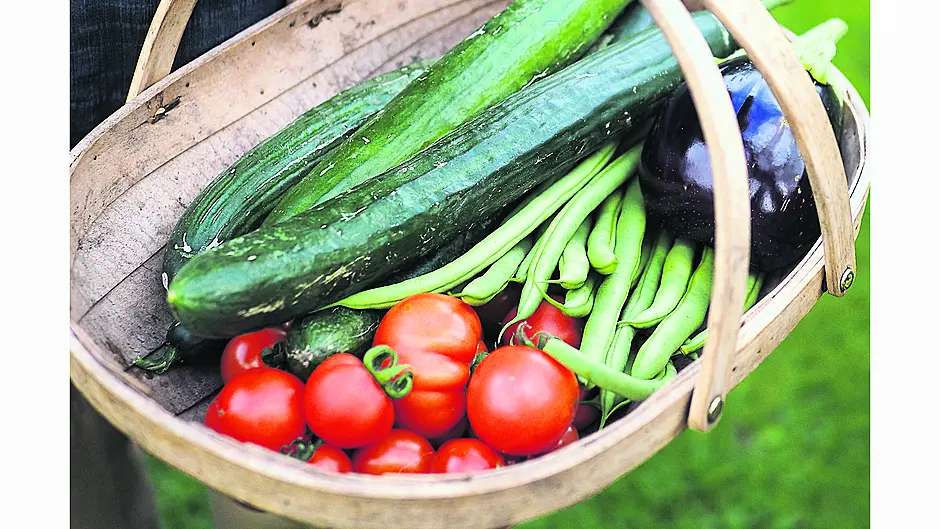By Joyce Russell
MOST plants have put on a growth spurt in the last few weeks. Some are still a week or two behind where they would usually be at this time of year, but most seem to be doing well and the vegetable garden is cropping as we would expect.
This month is a real reminder of how much can be harvested from even the smallest of plots. It has been a great year for peas and beans of all kinds – keep harvesting while pods are at their best and any surplus will freeze very well. Courgettes and cucumbers seem to grow overnight, salad leaves shoot up in a couple of weeks, and plenty of tomatoes are colouring up to allow picking on a regular basis. Onions and garlic grew very decent bulbs and these can be dried out to last for months.
Pick fruit and vegetables every day or two if you can, so you get to pick things when they are at their best. Try to use herbs before they flower – dry them in bunches or freeze chopped herbs in ice trays filled with water. There’s real pleasure to be got from storage spaces filling up with your own delectable produce.
Flower borders
Some early flowering plants will have finished their display in the herbaceous border. You might get a late flush of flowers from some, if you trim off dead flower spikes. Others won’t flower again, but it is always worth standing back and considering before you chop stems down to the ground. If perennial plants have green leaves, then they will still be putting energy down into the root mass underground and can be left a while longer. If leaves have yellowed and stems started to rot, then you may as well cut them right back to make things more slightly. You can cut out all dead parts of course, but some plants look rather lovely with dried seed pods or delicate browning stems. These make a feature out of what might otherwise be an empty spot in the garden.
Flower bulbs
Keep an eye out for the arrival of flowering bulbs in garden shops. There should be a good choice if you buy these before boxes are emptied. Choose firm bulbs that haven’t started to sprout and they will store for a few weeks in a cool shed until you are ready to plant them.
Bulbs make great gap-fillers and they can provide height where needed. Narcissi, crocus and tulips are always favourites, but it’s worth trying a few others. Anemone, Iris reticulata, muscari, fritillary and cyclamen are all pretty reliable early flowering bulbs, provided they aren’t left to rot in wet ground.
Try alliums for a spectacular spring to summer display and Calla lilies will flower from summer through into autumn. There are many other options, of course, so take your time to choose what you want to buy.
Bulbs thrive in a well-drained bed and most produce good displays in large pots and containers. Growing in containers makes it easier to control the growing medium to suit individual needs – snowdrops do best in an alkaline soil rather than an acid one, for example.
Plant the contents of containers out in the garden when they have finished flowering and they should provide a good display for several years.
Fabulous figs
Fig trees can be very productive in our climate provided they are grown in a sheltered position with enough sun. A south facing wall is good and my fig tree does very well on a west facing one. The wall provides shelter and traps some heat from the sun. Cold and late winds in the spring led to the loss of some small fruits, but enough swelled and ripened to give a delicious harvest.
Pick fruits when they soften and the neck flops over. Get them before they fall to the ground and before birds peck holes and wasps fly in to feast. It takes a little vigilance, but you should manage to get the best of the crop to eat. If ripe fruits suffer before you get them, then you can pick a little early and spread fruit out in a sunny indoor spot to finish the ripening process. If you leave them more than a couple of days they will start to deteriorate.
Some late August jobs
• Sow spinach, salad leaves, spring cabbage, lettuce, radish and turnips if you want fresh crops for the colder months. Choose winter varieties where available and sow in a greenhouse or polytunnel for best results.
• Turn the compost heap over and add in more layers of nitrogen-rich material if needed. The idea is to aerate the heap and keep it heating and working for as long as possible.
• Tidy the shed to make space for your tools and vegetable stores.









